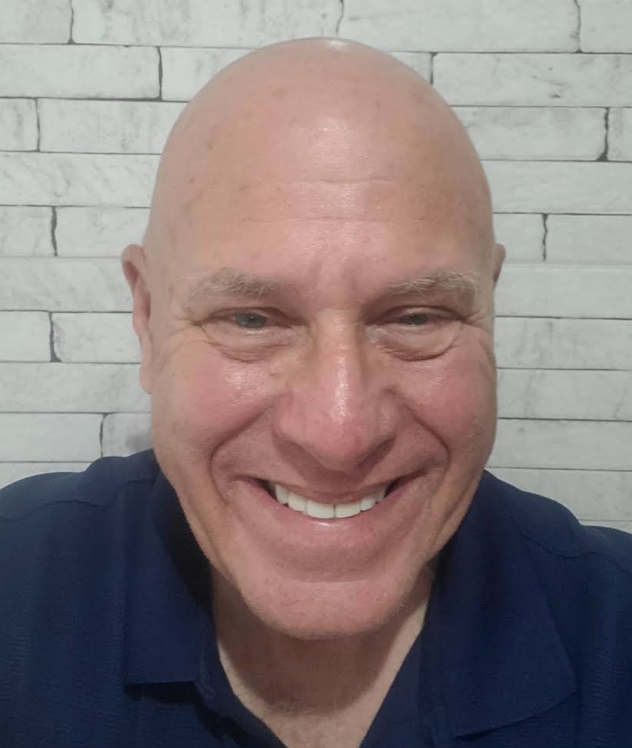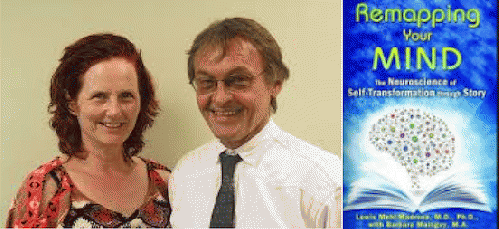Broadcast 10/28/2016 at 5:34 PM EDT (7 Listens, 13 Downloads, 1913 Itunes)
The Rob Kall Bottom Up Radio Show Podcast
| Copyright © Rob Kall, All Rights Reserved. Do not duplicate or post on youtube or other sites without express permission. Creative commons permissions for this site do not apply to audio content or transcripts of audio content. | ||||
This is part 2 of a two part interview, which follows part one, here: How To Use Stories to Re-Program Your Mind-- Lewis Mehl Madrona and Barbara Mainguy
Lewis Mehl-Madrona, M.D., PhD. is a physician and a Native American healer/ Lakota shaman. He is associate professor at the University of New England College of Osteopathic Medicine and executive director of the Coyote Institute for Studies of Change and Transformation. he's the author of Many books on story, a repeat guest on this radio show and, back when I ran the Storycon Summit Meeting on the Art Science and Application of Story, he was a regular participant.
Barbara Mainguy is a psychotherapist and education director for the Coyote Institute for Change and Transformation.
We're discussing Neuroscience of Self transformation Through Story
Coyoteinstitute.us Mehl-Madrona.com
Very Rough Interview Notes:
Rob; What would you do with someone with an authoritarian personality-- who needed authoritarian people telling them what to do.
Lewis--- find their ruler, king.
Barbara-- I had a client who had an old-testament god who couldn't be challenged.
We came up with an inner rabbi who could argue with the old testament god.
So you would look for the actual people in your life
Rakel in St. Louis in Washington University
Default mode of the brain is to make up stories" what the brain does when it is on idle, and this is what the brain is designed to do
Three D Brain App from Coldspring".
Part of the brain the executive brain-- does lists. In order to do executive function you have to turn off the default, story brain.
Efficiency is the enemy of story and vice versa. Then there's error detection in story. That allows us to correct the story.
These circuits make nice metaphors for helping people to understand how they move around in the world.
Rob: What's the best brain metaphor that you use?
I tell the story of how the genes only put the neurons in s oct of the right place. And then, it's what happens to you in the first seven years that determine how the brain/. But to hook them up correctly you need social experience.
Rob: That's what Allen Schore talks about
It helps people by showing that they are not doomed by their genetics and shows that the brain is shaped by our social environment. So if you want to change, you have to change your social environment. If you have a problem with drinking you need to find sober friends. It's more effective to change our environment if we want to be different.
Change the environment and the connections change.
Rob: How does that work in an aboriginal tribe.
You may have to run away. The plus side of being in a tribe is everyone is wo ring to soothe each other.
We don't have tribes-- we don't have social networks that let us know when we are on or off track. I think we would be tremendously happier if we had more of that tribal experience in our lives, if we were more connected with other people .That's an aspect of Facebook-- it's a two edged story-- helps us and interferes at the same time. This is one of the big quandaries
Rob: How does story brain tie in with Bottom-up and top-down brain processes?
We're forced by the nature of our brains to do a lot of top-down processing. We need a story to tell us how to separate foreground from background, what objects to pay attention to and to ignore.
A Japanese study showed Americans paid more attention to foreground. These reflect different stories of what matters to us. Once you have a workable top-down perception story, you may never discover there are different ways to organize the pixels. Most of our stories on how to perceive the world are in place by age seven. It takes an effort to go bottom-up . This is what we do in our workshop--- to help people to take a different view of the world-- to assemble the data differently. This is what we mean by re-storying.
Rob: What's Tie between body and story.
Barbara: People talk about metaphor as the language of the body. Our bodies act as little encoding devices-- muscle memory. There's a tremendous relationship with our bodies and the stories we are telling. We will w ork with body work and stories. In trauma they talk about unspeakable stories and they can often be expressed in the body. And you can often work with them with movement. You might begin with image s and colors and dynamics as they are doing this-- they might feel heaviness or lightness or the word bluebird comes to them. Often you get these that stories that emerge from the stories that come from their bodies. it's a a way of really working bottom up.
We use improv a lot-- improvisation-- we get very physical with it. We often doing things more quickly and easily when you are on your feet. There's a form of I'm
David Reed Johnson-- developmental transformation-- it's a really no-hold barred improv"
We're embodied minds. Our minds and bodies are not so separate .
Rob: You talk about healing one patient-- that her stories were looking for a home. You've healed people with cancer, irritable
Lewis. It's more complex than to say we healed them with stories. But story is an integral part of the healing process. It's because the brain, mind and body are one seamless whole. Human beings are not organized like medical school departments are. We've watched some miraculous events and I wouldn't say I created them but would say that I was a part of them.
Rob: You talk about how the Lakota describe a Nagi-- a swarm of stories that make up our identity-- our master narrative.
Lewis: The metaphor is swarm of bees around your and each of those bees is a story and each of them have a spirit in it. In this concept a person changes as they take new stories in their nagi. And who they represents the balance among the stories within their nagi.
It's a marvelous way of thinking about self. It necessarily includes history and environment.
Rob: This make me think of systems theory;
IT is systems theory that indigenous people had 40,000 years ago, in Australia
Rob: How is nagi and story systems theory
Systems theory is that we are all connected that there is no isolated action that doesn't affect the whole, that things can emerge".
The way to make things happen is to interact and that produces things that you could have never anticipated.
Even you want to change something get people together and interact. We don't have to know how.
Rob: are there Top down vs bottom up stories
Top down stories are about beings imposing their will upon the world
BU stories are about people wandering around and discovering things a figuring them
Coyote would like to impose his will upon the world but it never works out.
BU stories are stories that teach us how to live with us in peace an harmony
TD stories are more this his how the creator made the world
Lakota creation story-- and Penobscot and Pasamaqody story-- the creative had to interact with the created to fine-tune creation.
Rob: One of the creation stories is the giant turtle-- that's a bottom up story-- There's a giant flood and someone has to dive down to the bottom of the ocean to get dirt start the world o ver again. Where do they put the dirt? They put the dirt on a turtle. What is the turtle standing on. It's turtles all the way down.
Rob: Turtles are us
Rob: what about Political Stories
The US is suffering from too many top down stories. Kill the bad people. That hasn't worked very well. A better story would be to go out and get to know people. War is the ultimate top-down story where people try to impose their force on another group and whoever wins the war has god's blessing.
Rob: do you have ideas about liberals and conservatives and their stories. Lakoff"
You tend to be labeled a liberal if you believe we're all in this together and we should help each other.
Conservative-- Ayn Rand story-- you can take".
Liberals or bernie sanders types tend to say there are finite resources, we need to learn how to share, your suffering is my suffering-- so how we going to get together and make this happen. If you think this way you'd probably be opposed to tax loopholes.
Rob: are there underlying stories that give people this way of seeing.
Whether we learn to care about other people or not. I once sat on an airplane next to two very conservative republicans and I asked, If someone comes into the emergency room and they don't have health insurance, do you want me to let them die? And they both said "absolutely."
Rob: but what are the stories that make them say, "let them die."
Lewis. I think it's the story of rugged individualism-- john Wayne, Charlton hEston, Horatio Alger-- If I'm successful it's because god predestined to me. I think it's a lack of appreciation of systems theory. If we really believe that we are islands unconnected to each other that we can go about with impunity.
Are we all relate d
In lakota we say, ho mitakuye oyasin. all my relations
Mirror Neurons, empathy, and story Narcissism and story
WE develop self awareness by observing other people watching us. As we develop self awareness we develop awareness of others.
Areas in the temporal lobe. We do this because it has survival value. I need to know your beliefs and desires" at the same time, as we build this sort of empathy this attachment dance in step with each other we begin to build stronger communities" we can easily shift where we are going all at the same time.
Some people find ways to get what they want without taking into account other people.
I heard on NPR that more bosses are ineffective bosses-- because what it takes to become a boss.
Rob: I'd like you to talk more about narcissism.
I suspect that it's a story a top-down imposed story that comes from with multiple bottom up stories that say I'm no good, I'm ineffective. The top down story is that I'm the cat's meow and the most important person in the universe.
YOu impose, you sort of muscle a story on all the other people around you.
Rob: Have you ever worked with narcissists-- Can you think of someone you helped and how you helped them.
A person came to me-- they were puzzled about why they weren't happily married. Why did people keep breaking up with them. I suggested they do some research-- track people down and ask them-- get data. The data revealed that they weren't as wonderful as they thought. They had to really rebuild their empathy system.
They had to become more sensitive to the environment, more sensitive to feedback.
It's a community process, really.
Rob: I got the impression that narcissists really don't connect with a community, that they engage in order to manipulate.
I think they really deeply want to connect. They may not be willing to do the work to get there, but they really want to be admired and loved, and they really hurt when they are not.
Rob: That I know
the disconnect is to be aware of feedback and modify behavior with reference to the feedback. and that's what the therapist does.
I don't think any strategy is unchangeable. all
Rob: how does Story fit into making change happen
making change happen means you try out a different story. You observe the feedback and decide whether you are going into a desirable.
Rob: I was thinking of change of organizations, cultures, etc.
Same process--
Companies have stories of what it is to be a good or bad employee, A company is a microcosm of the world.
Rob: Any advice to someone involved with making change in how to use stories.
Keep talking
Rob: I've kept you talking long enough
The more we get together as human beings and talk-- and talking in order to listen, the more we will improve our world.
Rob: what do you meaning "talking to listen?"
being able to absorb their response without quickly batting it away or being defensive.
You say: "We need each other. We are designed to be with each other, not to live in isolation. Being compassionate is powerfully healing for us. We should make an effort to get together with each other--
Size: 28,979,954 -- 1 hrs, 0 min, 22 sec










